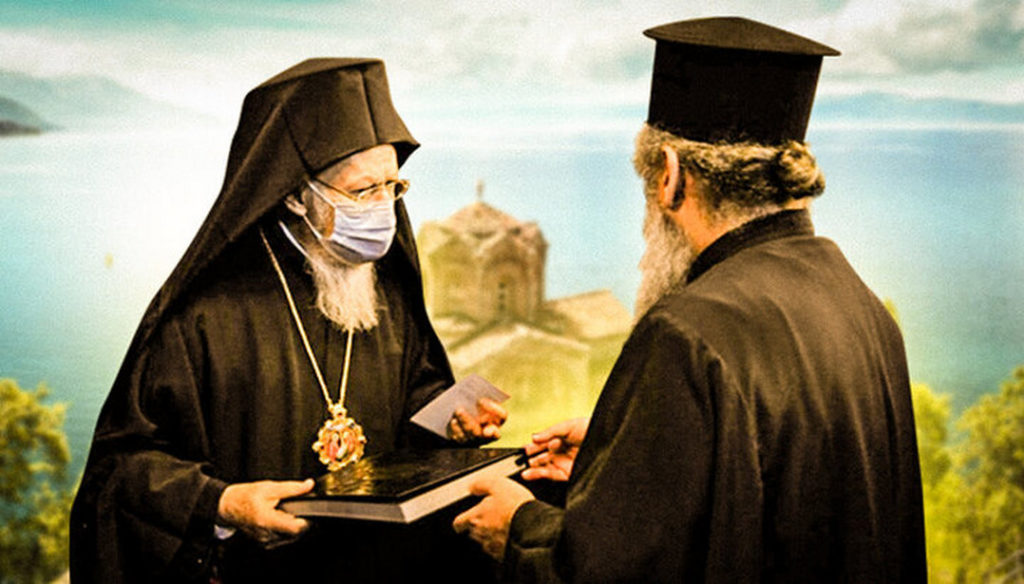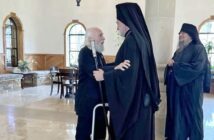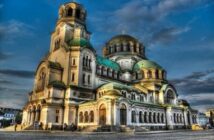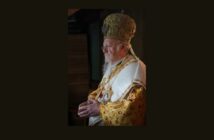Source: Union of Orthodox Journalists

Is Patriarch Bartholomew following the path of legalizing the Macedonian schism? Photo: UOJ
Originally published on December 20, 2021
The Phanar received Macedonian schismatics. What is this – revenge to the Serbian Church for non-recognizing the OCU or a global policy of legalizing all schismatics?
On 16 December, Patriarch Bartholomew received a delegation from the so-called Macedonian Church at the Phanar. Does this mean the start of another Tomos for the schismatics, and how might this affect the entire Orthodoxy?
 The delegation of the “Macedonian Orthodox Church” at the Phanar. Photo: religija.mk
The delegation of the “Macedonian Orthodox Church” at the Phanar. Photo: religija.mk
Analyzing the visit of the Macedonian schismatics to the Phanar, three points should be noted:
- The delegation itself was very personable. There were “monastics” from four monasteries of the “Macedonian Church”, and the delegation was headed by “Bishop” Parthenius (Fidanovsky) of Antania.
- In addition to Patriarch Bartholomew, the meeting was attended by the second-ranked Phanar bishop, Metropolitan Emmanuel (Adamakis) of Chalcedon, that very bishop who conducted the entire process of legalizing Ukrainian schismatics, granting them the Tomos, and directly headed the so-called “Unification Council” on December 15, 2018, at which the Orthodox Church of Ukraine (OCU) was created.
- The reception given to the Macedonian schismatics at the Phanar was very warm. “His Holiness Patriarch made a corresponding address, in which he expressed his fatherly concern for all of us and our Church. In the end, we all received a blessing from him by kissing his holy right hand,” said one of the members of the Macedonian delegation.
Who are Macedonian schismatics
The Macedonian schismatics themselves claim to trace their history back to the Orthodox Archdiocese of Ohrid, which existed in the 11th-18th centuries. This archdiocese arose in 1019 when the Byzantine Emperor Basil the Bulgar Slayer defeated Bulgaria and included it in Byzantium’s sphere of influence. Accordingly, the independent Bulgarian Church, which before that not only had had autocephaly but also the status of the patriarchate, was abolished, and in its place arose the Archdiocese of Ohrid with the status of autonomy within the Patriarchate of Constantinople.
The canonical territory of the Archdiocese of Ohrid was quite extensive: it included Bulgaria, Macedonia, Serbia, and Romania. Accordingly, when political circumstances changed, the Churches in these countries separated from the Archdiocese of Ohrid and restored (or acquired) their autonomous or autocephalous status. In 1767, the Turkish Sultan abolished the Archdiocese of Ohrid, subordinating it to the Patriarchate of Constantinople as the Prespanian Metropolis. In 1913, the episcopal see in Ohrid became part of the Serbian Orthodox Church, in 1915 – Bulgarian, in 1919 – again Serbian, in 1941 – again Bulgarian, and from 1945 to this day it has been part of the Serbian Orthodox Church.
As we can see, history is very complicated, it has many zigzags, which can be speculated on if desired to satisfy various political ambitions. Thus, there are historical reasons to say that the Archdiocese of Ohrid can act as the “Mother Church” for the Serbian Church. But one can also find arguments for the opposite statement that the Serbian Church can be the same “Mother Church” for the Archdiocese of Ohrid, as indeed was the Bulgarian Church, which the Archdiocese of Ohrid was also part of for some time.
After World War II, Macedonia became part of Yugoslavia, whose authorities supported the idea of creating an autonomous Macedonian Orthodox Church with a centre in Ohrid. However, the Serbian Church opposed this. It was not possible to come to an agreement, and in 1967 autocephaly of the Orthodox Church of the Republic of Macedonia was proclaimed. It was not recognized by either the Serbian or any other Local Church, including the Constantinople Church.
In 1998, there was an attempt to heal the Macedonian schism. Negotiations began between representatives of the Serbian Church and the Macedonian schismatics, which lasted 4 years and culminated in the signing of the Treaty of Niš (2002), according to which the “Macedonian Church” received the rights of the broadest autonomy within the Serbian Church. In fact, the status of the “Macedonian Church” was supposed to be similar to the status of the Ukrainian Orthodox Church, but the political authorities of Macedonia, striving to tear their country away from Serbia as much as possible, did not allow the hierarchs of the “Macedonian Church” to approve the Treaty of Niš at the Council.
The breakdown of the Treaty of Niš led to the fact that a significant number of Macedonian believers led by Metropolitan Jovan (Vraniškovski) of Veles and most of the monastics came out of the schism and restored communion with the Serbian Patriarch. Organizationally, they formed the Archdiocese of Ohrid, which the Serbian Church decided to re-establish. At the moment, the authorities of North Macedonia (the modern name of Macedonia) do not recognize the Archdiocese of Ohrid and even have arrested Metropolitan Jovan (Vraniškovski) several times. But the schismatic “Macedonian Church” enjoys their full support.
Attempts to gain autocephaly
The refusal of the Serbian Church to grant autocephaly to the Macedonians forced them to look for other ways to obtain the desired status. In 2005, the secular authorities of the Republic of Macedonia asked Patriarch Bartholomew to intervene and regulate the canonical status of the “Macedonian Church”. But in those days, Patriarch Bartholomew was still concerned about the unity of Orthodoxy and preferred not to stir up conflict. In 2009, the “Macedonian Church” decided to rename and announced the adoption of the historical name “the Archdiocese of Ohrid”. That is, the official name became “the Macedonian Orthodox Church – Ohrid Archbishopric”. This was done also because the Greeks explained to the Macedonians that they would not tolerate the word “Macedonia” either in the name of the Church or in the name of the country itself. This is explained by the fact that within Greece there is an area with the same name. The Macedonians resisted for a long time, but in 2018 they still agreed to rename their country to the Republic of North Macedonia.
In 2017, the Synod of the “Macedonian Church” made a rather creative attempt to get hold of the status of autocephaly. It turned to the Bulgarian Orthodox Church (BOC) with a proposal to recognize it as his “Mother Church” in exchange for the establishment of Eucharistic communion and subsequent autocephaly. The Bulgarians responded favourably, and on November 27, 2017, the Holy Synod of the BOC adopted a resolution stating that if the “Macedonian Church” recognizes it as the “Mother Church”, then the BOC “undertakes to provide full assistance and intercession before the Local Orthodox Churches having done everything that is necessary to establish the canonical status of the MOC”. In other words, it will try to persuade the Local Churches to recognize the autocephaly of the Macedonians from the Bulgarians. The BOC even created a special commission on the case of the Macedonian Church, and the Bulgarian patriarch Neophytos hosted the leader of the Macedonian schismatics.

However, the idea was immediately strongly opposed. The Holy Synod of the Greek Orthodox Church said it was unacceptable for the Bulgarian Church to interfere in the Serbian jurisdiction, while the Holy Synod of the Patriarchate of Constantinople stated it considered the actions of the Bulgarian Church as anti-canonical on the grounds that autocephaly, in their view, can only be given by the Phanar. The Bulgarians backtracked and rejected the honorary title of “Mother Church”.
Notably, in April 2018, Ukrainian President Petro Poroshenko and Macedonian President Gjorge Ivanov were both negotiating autocephaly for their religious projects at the Phanar almost simultaneously. Patriarch Bartholomew met with both but decided to be cautious and not act on two fronts at once. And of course, Ukraine for the Phanar is a much tastier deal than Macedonia. Therefore, the subject of autocephaly for Poroshenko was given the green light at the Phanar, while the Macedonian President was told to wait. However, in January 2019 both he and Montenegrin President Milo Đukanović, who was also promoting his religious project “Montenegrin Orthodox Church”, were encouraged by the so-called exarch of Constantinople in Ukraine, Archbishop Daniel (Zelinsky) of Pamphylia. In an interview with the BBC, he said: “I support the thesis that every nation that wishes to have its own Orthodox Church should have the right to establish it and ask for its recognition by the other Orthodox Churches, including when it comes to Macedonia and Montenegro.”
At the beginning of 2020, former North Macedonian Prime Minister Zoran Zaev (now the Prime Minister again) and acting Prime Minister Oliver Spasovski came to the Phanar for talks.

They held talks with Patriarch Bartholomew about autocephaly for their religious project. The Macedonian media even reported that the head of the Phanar received an appeal of the “Macedonian Church” against the decisions of the Serbian Orthodox Church. However, Patriarch Bartholomew has not made any statement about starting the process of granting autocephaly to the Macedonians.
Interestingly, on July 9, 2019, Russian pranksters Vovan and Lexus published a recording of a conversation in which they, posing as Phanar representatives, asked Zoran Zaev for a bribe of €100,000 for Patriarch Bartholomew to obtain autocephaly for the Macedonian Orthodox Church. During the conversation, the politician agreed to the bribe. Z. Zayev confirmed the very fact of the conversation, and as for the bribe, he said that the recording was set up.
Phanar’s interference in Ukraine
In 2018, the Patriarchate of Constantinople intervened in church affairs in Ukraine, and this fundamentally changed the whole landscape. It was very important for the Phanar to launch the process of recognizing the OCU by the Local Churches. To this end, American diplomats (primarily) and Phanariots paid visits to Orthodox countries to force the hierarchs of the respective Local Churches to make the “right” decision. Besides, the Phanar tried to refrain from actions that could act as irritants in the relations with individual Local Churches. Therefore, the topic of autocephaly for the Macedonian and Montenegrin “Churches” was put on hold. In addition, the Phanar’s threat to give the green light to autocephalous projects in North Macedonia and Montenegro is a powerful argument to put pressure on the Serbian Church to recognize the OCU.
In the three years that have passed since the creation of the OCU, this organization has been recognized by only three local Churches: Greece, Cyprus and Alexandria. It was done with big reservations – half of the Cypriot bishops did not recognize the OCU, in Greece there are hierarchs who adhere to the same position. The so-called Slavic Local Churches, for the most part, unambiguously declared the impossibility of recognizing the OCU. In fact, a schism has emerged in Orthodoxy. It is most serious in the relations between the Russian Orthodox Church and the Phanar, which have no eucharistic communion.
It should be noted that the issue of recognition or non-recognition of the OCU does not exist by itself. It goes along with two other topics the Phanar is promoting. This is a question of recognizing a special position in Orthodoxy and exclusive rights in the whole Church for the Patriarch of Constantinople, as well as a question of ecumenical unification with the Catholic Church in the very near future. Most of the hierarchs in the Local Churches are fully aware of the fact that having recognized the OCU, they thereby recognize the primacy of the Phanar in Orthodoxy, and having recognized this primacy, they will be forced to follow the Phanar into a new union with the Catholics.
Now the Local Churches are conditionally divided into two camps – the ones that recognized the Phanar’s primacy (and, consequently, the legitimacy of the OCU), and those which consider the theory of “the first without equals” to be the heresy of “Constantinople papism”. These are mainly the Local Churches that took part in the meeting in Amman in February 2020: Jerusalem, Russian, Polish, Serbian, Romanian and the Church of the Czech Lands and Slovakia. These Local Churches represent approximately 80% of all Orthodox believers on the planet.

To date, the Phanariots have realized that they have already exhausted means of pressure on these Churches, and thus it is time to move on to further actions, in particular – to the projects of legalizing Macedonian and Montenegrin schismatics.
Position of the Serbian Church
The Serbian Church unambiguously and consistently declares non-recognition of the OCU. In early 2019, as reported by the Belgrade newspaper Politika, it sent a letter to all Orthodox Churches that it does not recognize the OCU and considers the Primate of the UOC, His Beatitude Onuphrius, the only legitimate Metropolitan of Kyiv.
In early 2021, following the death of Patriarch Irinej of Serbia, Patriarch Porfirije, who also holds this view, became the Primate of the SOC. Even before his election as Patriarch, he declared: “We do not recognize unrepentant Ukrainian schismatics as members of the Church, let alone a normal autocephalous Orthodox Church.”
Amusingly, the head of the OCU, Sergei Dumenko, also sent Patriarch Porfirije a congratulatory letter on the occasion of his election, calling him his “brother”.
Apparently, for some time the Phanariots were waiting to see if the new Serbian Patriarch would become more conformable than his predecessor, but their expectations were in vain. Therefore, it’s time to act and decide something with regard to the Macedonian and Montenegrin “Churches”.
The vicar of the Patriarch of Serbia Porfirije, Bishop Anthony (Pantelič) of Moravici, spoke about the reaction of the Serbian Church to the recognition of the Macedonian and/or Montenegrin schismatics at the International Theological Conference at the Kyiv Caves Lavra “Catholicity of the Church: Theological, Canonical and Historical Dimensions”: “If any decisions are made on the issue of Macedonia and Montenegro, we can most likely expect such an unfortunate phenomenon which could break the eucharistic relationship between Constantinople and the Serbian Church.”
This position is well known to Patriarch Bartholomew, but, nevertheless, he decided to host a representative delegation of Macedonian schismatics at the Phanar.
How events can develop
As in the case of Ukraine, the Phanar’s position on Macedonia and Montenegro will be largely influenced not by religion but by politics. And by and large, whether or not to give Macedonian and Montenegrin schismatics autocephaly will be decided not at the Phanar but in the bowels of the American administration. However, this decision will still take into account the internal political situation in Northern Macedonia and Montenegro. It is quite different. In Northern Macedonia, the authorities clearly support the non-canonical Macedonian Church and actively lobbies for it to receive the Tomos from Patriarch Bartholomew. the Archdiocese of Ohrid, on the other hand, as part of the SOC, has been persecuted. Given these circumstances, the granting of autocephaly to the Macedonian Church can be considered highly probable.
As for Montenegro, in 2020 the party of President Milo Đukanović, an active supporter of the non-canonical Montenegrin Church, lost the parliamentary elections. The majority in the parliament and, accordingly, the Cabinet of Ministers was formed by the parties supporting the SOC. Zdravko Krivokapić, who positions himself as a SOC believer, became Prime Minister, who according to the Montenegrin constitution has real power in the country. Nevertheless, M. Đukanović retained his position as President of the country. After the power changed in Montenegro, the law according to which practically all church property was to be given to the schismatics was abolished. However, today it cannot be said that the government unequivocally favours the SOC. In May 2021, Z. Krivokapić refused to sign a “basic agreement on legal status” with the Serbian Church at the very last moment. Serbian media suggested this was done under pressure from Western embassies. The SOC stated that the failure to sign the agreement “constitutes an act of open discrimination”.
Based on this, it can be argued that if the US diplomats fail to persuade the Montenegrin authorities to return to the project of autocephaly of the “Montenegrin Church” (such a turn has taken place in Ukraine), there will be no Tomos for this religious structure. If Z. Krivokapić shows weakness and supports this project, then with high probability, following the Macedonian schismatics, the Montenegrin schismatics will also receive their Tomos.
The consequences for Orthodoxy in the event of such a development are not difficult to foresee. The Serbian Church will break the eucharistic communion with the Phanar, the negotiations in the Amman format will receive a new powerful impetus for their activation, and those Local Orthodox Churches that are still undecided will be forced to resolve this issue as soon as possible.



